The Intel 9th Gen Review: Core i9-9900K, Core i7-9700K and Core i5-9600K Tested
by Ian Cutress on October 19, 2018 9:00 AM EST- Posted in
- CPUs
- Intel
- Coffee Lake
- 14++
- Core 9th Gen
- Core-S
- i9-9900K
- i7-9700K
- i5-9600K
CPU Performance: System Tests
Our System Test section focuses significantly on real-world testing, user experience, with a slight nod to throughput. In this section we cover application loading time, image processing, simple scientific physics, emulation, neural simulation, optimized compute, and 3D model development, with a combination of readily available and custom software. For some of these tests, the bigger suites such as PCMark do cover them (we publish those values in our office section), although multiple perspectives is always beneficial. In all our tests we will explain in-depth what is being tested, and how we are testing.
All of our benchmark results can also be found in our benchmark engine, Bench.
Application Load: GIMP 2.10.4
One of the most important aspects about user experience and workflow is how fast does a system respond. A good test of this is to see how long it takes for an application to load. Most applications these days, when on an SSD, load fairly instantly, however some office tools require asset pre-loading before being available. Most operating systems employ caching as well, so when certain software is loaded repeatedly (web browser, office tools), then can be initialized much quicker.
In our last suite, we tested how long it took to load a large PDF in Adobe Acrobat. Unfortunately this test was a nightmare to program for, and didn’t transfer over to Win10 RS3 easily. In the meantime we discovered an application that can automate this test, and we put it up against GIMP, a popular free open-source online photo editing tool, and the major alternative to Adobe Photoshop. We set it to load a large 50MB design template, and perform the load 10 times with 10 seconds in-between each. Due to caching, the first 3-5 results are often slower than the rest, and time to cache can be inconsistent, we take the average of the last five results to show CPU processing on cached loading.
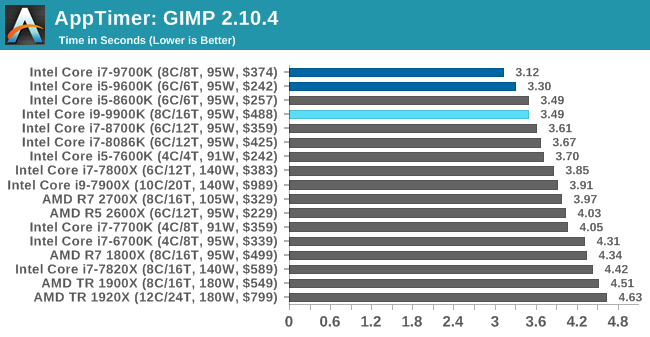
Application loading is typically single thread limited, but we see here that at some point it also becomes core-resource limited. Having access to more resources per thread in a non-HT environment helps the 8C/8T and 6C/6T processors get ahead of both of the 5.0 GHz parts in our testing.
FCAT: Image Processing
The FCAT software was developed to help detect microstuttering, dropped frames, and run frames in graphics benchmarks when two accelerators were paired together to render a scene. Due to game engines and graphics drivers, not all GPU combinations performed ideally, which led to this software fixing colors to each rendered frame and dynamic raw recording of the data using a video capture device.
The FCAT software takes that recorded video, which in our case is 90 seconds of a 1440p run of Rise of the Tomb Raider, and processes that color data into frame time data so the system can plot an ‘observed’ frame rate, and correlate that to the power consumption of the accelerators. This test, by virtue of how quickly it was put together, is single threaded. We run the process and report the time to completion.
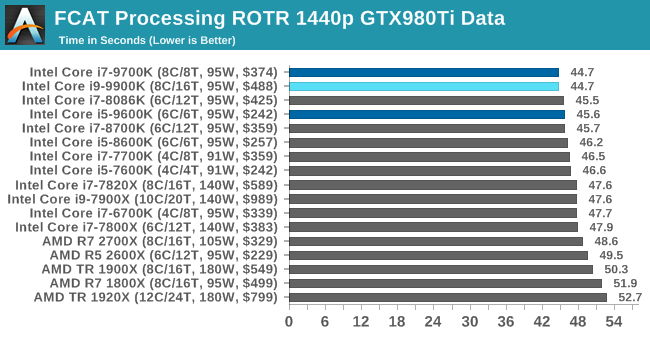
FCAT is another single thread limited scenario, and it looks like the new 9th gen parts do very well here. The 9700K and 9900K get the same time, split by milliseconds.
3D Particle Movement v2.1: Brownian Motion
Our 3DPM test is a custom built benchmark designed to simulate six different particle movement algorithms of points in a 3D space. The algorithms were developed as part of my PhD., and while ultimately perform best on a GPU, provide a good idea on how instruction streams are interpreted by different microarchitectures.
A key part of the algorithms is the random number generation – we use relatively fast generation which ends up implementing dependency chains in the code. The upgrade over the naïve first version of this code solved for false sharing in the caches, a major bottleneck. We are also looking at AVX2 and AVX512 versions of this benchmark for future reviews.
For this test, we run a stock particle set over the six algorithms for 20 seconds apiece, with 10 second pauses, and report the total rate of particle movement, in millions of operations (movements) per second. We have a non-AVX version and an AVX version, with the latter implementing AVX512 and AVX2 where possible.
3DPM v2.1 can be downloaded from our server: 3DPMv2.1.rar (13.0 MB)
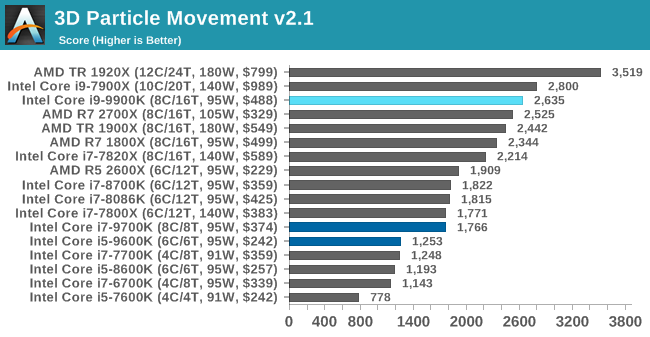
With a non-AVX code base, the 9900K shows the IPC and frequency improvements over the R7 2700X, although in reality it is not as big of a percentage jump as you might imagine. The processors without HT get pushed back a bit here.
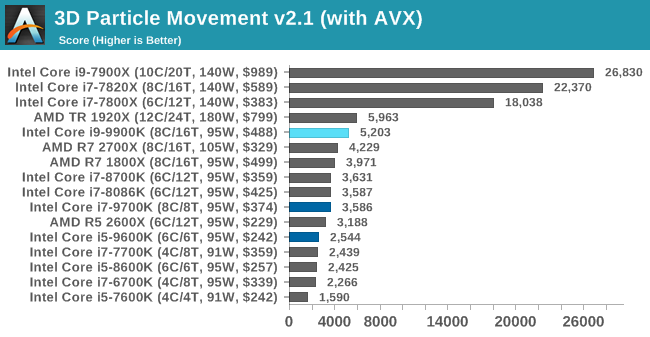
When we factor in AVX2/AVX512, the Skylake-X processors go off into a world of their own. The 9900K gets a bigger jump on the R7 2700X, more in line with what we expect, and the Core i7-9700K gets a boost as well.
Dolphin 5.0: Console Emulation
One of the popular requested tests in our suite is to do with console emulation. Being able to pick up a game from an older system and run it as expected depends on the overhead of the emulator: it takes a significantly more powerful x86 system to be able to accurately emulate an older non-x86 console, especially if code for that console was made to abuse certain physical bugs in the hardware.
For our test, we use the popular Dolphin emulation software, and run a compute project through it to determine how close to a standard console system our processors can emulate. In this test, a Nintendo Wii would take around 1050 seconds.
The latest version of Dolphin can be downloaded from https://dolphin-emu.org/
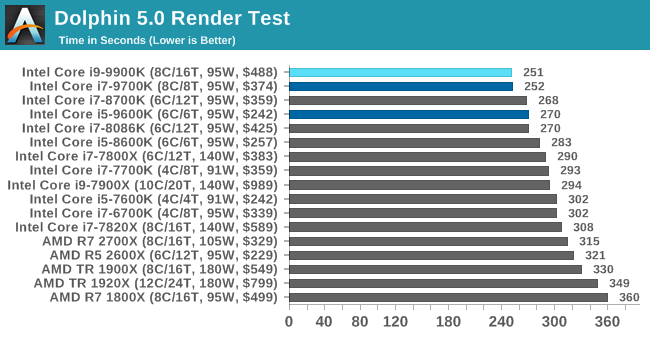
Dolphin is another single thread limited scenario, wher Intel processors have historically done well. Here the 9900K nudges out the 9700K by a second.
DigiCortex 1.20: Sea Slug Brain Simulation
This benchmark was originally designed for simulation and visualization of neuron and synapse activity, as is commonly found in the brain. The software comes with a variety of benchmark modes, and we take the small benchmark which runs a 32k neuron / 1.8B synapse simulation, equivalent to a Sea Slug.
Example of a 2.1B neuron simulation
We report the results as the ability to simulate the data as a fraction of real-time, so anything above a ‘one’ is suitable for real-time work. Out of the two modes, a ‘non-firing’ mode which is DRAM heavy and a ‘firing’ mode which has CPU work, we choose the latter. Despite this, the benchmark is still affected by DRAM speed a fair amount.
DigiCortex can be downloaded from http://www.digicortex.net/
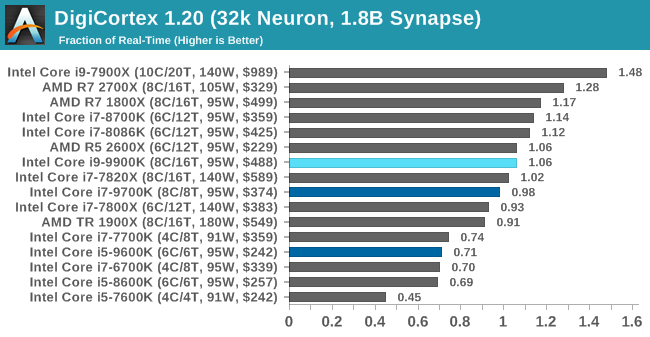
DigiCortex runs high on CPU performance and memory bandwidth, but it seems here that a 6-core Ryzen can match the 8-core 9900K pretty easily. the 8700K/8086K seem to do better on this test as well.
y-Cruncher v0.7.6: Microarchitecture Optimized Compute
I’ve known about y-Cruncher for a while, as a tool to help compute various mathematical constants, but it wasn’t until I began talking with its developer, Alex Yee, a researcher from NWU and now software optimization developer, that I realized that he has optimized the software like crazy to get the best performance. Naturally, any simulation that can take 20+ days can benefit from a 1% performance increase! Alex started y-cruncher as a high-school project, but it is now at a state where Alex is keeping it up to date to take advantage of the latest instruction sets before they are even made available in hardware.
For our test we run y-cruncher v0.7.6 through all the different optimized variants of the binary, single threaded and multi-threaded, including the AVX-512 optimized binaries. The test is to calculate 250m digits of Pi, and we use the single threaded and multi-threaded versions of this test.
Users can download y-cruncher from Alex’s website: http://www.numberworld.org/y-cruncher/
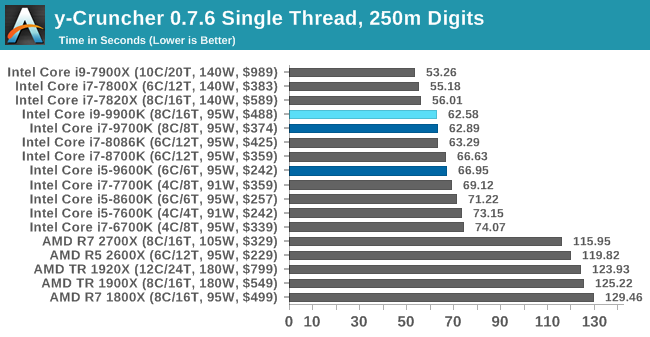
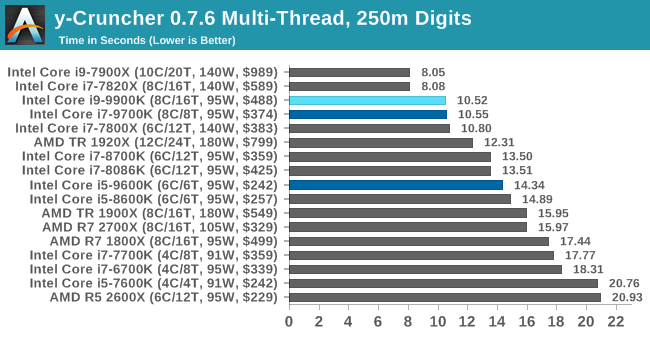
As y-cruncher has AVX2/AVX512 benefits, we see the Skylake-X processors again go off in their own little world. In multi-threaded, it takes 8 cores in the 9900K/9700K to get beyond a 6-core AVX512 enabled part.
Agisoft Photoscan 1.3.3: 2D Image to 3D Model Conversion
One of the ISVs that we have worked with for a number of years is Agisoft, who develop software called PhotoScan that transforms a number of 2D images into a 3D model. This is an important tool in model development and archiving, and relies on a number of single threaded and multi-threaded algorithms to go from one side of the computation to the other.
In our test, we take v1.3.3 of the software with a good sized data set of 84 x 18 megapixel photos and push it through a reasonably fast variant of the algorithms, but is still more stringent than our 2017 test. We report the total time to complete the process.
Agisoft’s Photoscan website can be found here: http://www.agisoft.com/
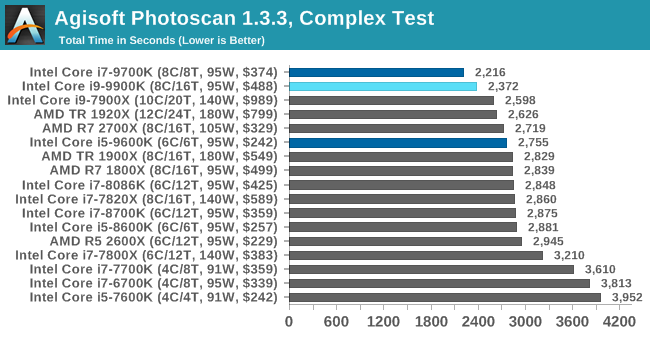
Photoscan is a task that seems to enjoy both high throughput, single threaded performance, and in this case it looks like having HT off as well.


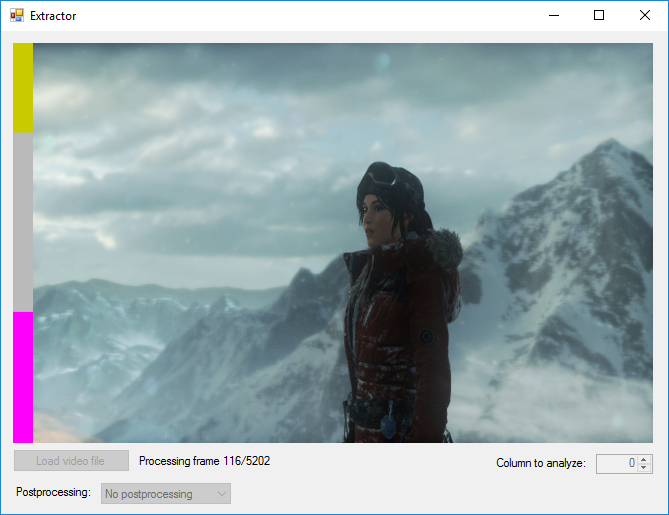










274 Comments
View All Comments
GreenReaper - Friday, October 19, 2018 - link
The answer is "yes, with a but". Certain things scale really well with hyperthreading. Other things can see a severe regression, as it thrashes between one workload and another and/or overheats the CPU, reducing its ability to boost.Cache contention can be an issue: the i9-9900K has only 33% more cache than the i7-9700K, not 100% (and even if there were, it wouldn't have the same behaviour unless it was strictly partitioned). Memory bandwidth contention is a thing, too. And within the CPU, some parts can not be partitioned - it just relies on them running fast enough to supplky the parts which can.
And clearly hyperthreading has an impact on overclocking ability. It might be interesting to see the gaming graphs with the i7-9700K@5.3Ghz vs. i9-9900K@5.0Ghz (or, if you want to save 50W, i7-9700K@5.0Ghz vs. i9-9900K@4.7Ghz - basically the i9-9900K's default all-core boost, but 400Mhz above the i7-9700K's 4.6Ghz all-core default, both for the same power).
NaterGator - Friday, October 19, 2018 - link
Any chance y'all would be willing to run those HT-bound tests with the 9900K's HT disabled in the BIOS?ekidhardt - Friday, October 19, 2018 - link
Thanks for the review!I think far too much emphasis has been placed on 'value'. I simply want the fastest, most powerful CPU that isn't priced absurdly high.
While the 9900k msrp is high, it's not in the realm of irrational spending, it's a few hundred dollars more. For a person that upgrades once every 5-6 years--a few hundred extra is not that important to me.
I'd also like to argue against those protesting pre-order logic. I pre-ordered. And my logic is this: intel has a CLEAR track record of great CPU's. There hasn't been any surprisingly terrible CPU's released. They're consistently reliable.
Anyway! I'm happy I pre-ordered and don't care that it costs a little bit extra; I've got a fast 8 core 16 thread CPU that should last quite a while.
Schmich - Friday, October 19, 2018 - link
You have the numbers anyway. Not everyone buys the highest end and then wait many years to upgrade. That isn't the smartest choice because you spend so much money and then after 2-3 years you're just a mid-ranger.For those who want high-end they can still get a 2700x today, and then the 3700x next year with most likely better performance than your 9900k due to 7nm, PLUS have money over PLUS a spare 2700x they can sell.
Same thing for GPU except for this gen. I never understood those who buy the xx80Ti version and then upgrade after 5 years. Your overall experience would be better only getting the xx70 but upgrading more often.
Spunjji - Monday, October 22, 2018 - link
This is what actual logic looks like!Gastec - Sunday, November 4, 2018 - link
Basically "The more you buy, the more you save" :-\shaolin95 - Friday, October 19, 2018 - link
Exactly. I think the ones beating the value dead horse are mainly AMD fanboys defending their 2700x purchaseeva02langley - Friday, October 19, 2018 - link
Sorry, value is a huge aspect. The reason why RTX is such an issue. Also, at this price point, I would go HEDT if compute was really that important for me.It is not with 10-15% performance increase over a 2700x at 1080p with a damn 1080 TI that I will see a justified purchase.
Arbie - Friday, October 19, 2018 - link
Gratuitous trolling, drags down thread quality. Do you really still need to be told what AMD has done for this market? Do you even think this product would exist without them - except at maybe twice the already high price? Go pick on someone that deserves your scorn, such as ... Intel.Great_Scott - Friday, October 19, 2018 - link
What a mess. I guess gaming really doesn't depend on the CPU any more. Those Ryzen machines were running at a 1Ghz+ speed deficit and still do decently.Intel needs a new core design and AMD needs a new fab.